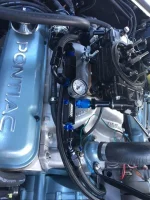The best fix is an electric pump with return line. A Q-jet likes, IIRC, 5-8psi.
However, what will probably (85-90%) work is this, and should run you-total-less than a hundred bucks...keep the heat away from the fuel. Get a 1/4-1/2" PLASTIC carb spacer-Mr. Gasket 3406 works, or if you're a woodworker, one cut from 1/2" wood might even work better. If so, just use a carb gasket as a template. If you don't have the height clearance for this (though a motorhome should), a thick foam gasket will usually work at least almost as well.
Either buy (eBay, ~$30, search "Quadrajet heat shield)) or make (sheetmetal and tin snips, test fit and trim as needed) a carb heat shield.
Wrap all the fuel lines anywhere near engine heat with insulation-best is foam pipe insulation (Home Depot, 6' pieces are about two bucks), though heater hose works surprisingly well.
Also, make sure the cooling is up to snuff...especially the fan clutch. In fact...maybe wire the fan clutch so the fan always spins and see if it vapor locks. (If not...you need a fan clutch.)
However, what will probably (85-90%) work is this, and should run you-total-less than a hundred bucks...keep the heat away from the fuel. Get a 1/4-1/2" PLASTIC carb spacer-Mr. Gasket 3406 works, or if you're a woodworker, one cut from 1/2" wood might even work better. If so, just use a carb gasket as a template. If you don't have the height clearance for this (though a motorhome should), a thick foam gasket will usually work at least almost as well.
Either buy (eBay, ~$30, search "Quadrajet heat shield)) or make (sheetmetal and tin snips, test fit and trim as needed) a carb heat shield.
Wrap all the fuel lines anywhere near engine heat with insulation-best is foam pipe insulation (Home Depot, 6' pieces are about two bucks), though heater hose works surprisingly well.
Also, make sure the cooling is up to snuff...especially the fan clutch. In fact...maybe wire the fan clutch so the fan always spins and see if it vapor locks. (If not...you need a fan clutch.)

